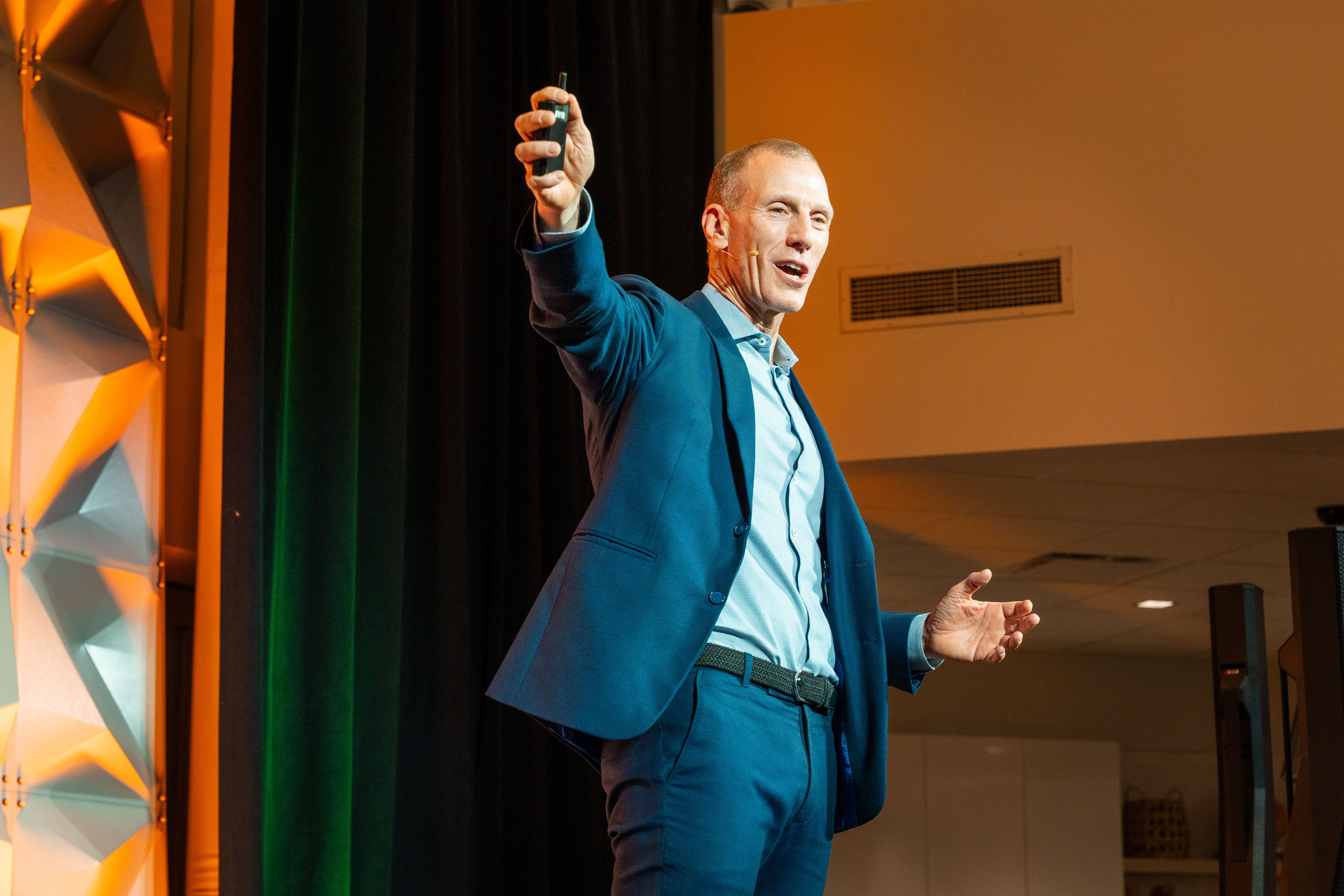
Jamie Metzl delivers the keynote address during the Aspire 2025 event at Stellix's headquarters in Foxborough, MA.
During our inaugural Aspire event, global thought leader Jamie Metzl captivated our audience with his perspective on the exponential and convergent advances in AI, genetic engineering, and biotechnology, as well as the implications those innovations have for what it means to be human in the 21st century. The key takeaway from his talk:
Life science leaders and organizations must rethink and supercharge their approach to collaboration if they’re going to transform the benefits of these intersecting innovations into better outcomes for patients.
We sat down with Jamie after his keynote for a brief conversation on the future of healthcare, the role of AI, and the urgent need to build a thriving innovative ecosystem.
Jamie, your keynote opened with a provocative idea: that humanity is now engineering novel intelligence and re-engineering life itself. What does that mean for healthcare?
JM: It means we’re in the middle of one of the most profound transformations in human history. After four billion years of life evolving on this planet, we’re suddenly able to direct it—intentionally and with increasing precision. In healthcare, that manifests in the shift from generalized, reactive medicine to something deeply personal, predictive, and preventive. But it also means we must grapple with enormous ethical, regulatory, and cultural questions today to help avoid potential pitfalls and build our best possible future.
You emphasized that this transformation isn’t something any one group can tackle alone. Why is collaboration so important right now?
The systems we are collectively building will have vast implications beyond the reach of any one person, company, or even country. Whether it’s developing privacy standards for genetic data, ensuring AI models are explainable, or integrating digital twins into care, we need scientists, regulators, ethicists, engineers, and—importantly—patients working together. We are all stakeholders. We are all part of the continuum.
The organizations that will thrive are those that view themselves not as silos, but as parts of dynamic innovation ecosystems where insights, responsibilities, and benefits can be shared.
The organizations that will thrive are those that view themselves not as silos, but as parts of dynamic innovation ecosystems where insights, responsibilities, and benefits can be shared.
Tell us more about this ecosystem idea. What does a healthy one look like in life sciences?
It’s inclusive. It’s interdisciplinary. It’s designed to scale trust and progress at the same time. In a thriving, healthy innovation ecosystem, breakthroughs don’t get stalled because of a lack of regulatory clarity or societal pushback. Patients aren’t left behind because technologies weren’t made with them in mind. Governance, ethics, and access are embedded in the innovation process—not bolted on later.
Crucially, a healthy ecosystem must make space for diverse voices—engineers, patients, storytellers, community leaders, and social scientists alike—because the future of medicine is not just technical, but cultural as well.
Crucially, a healthy ecosystem must make space for diverse voices—engineers, patients, storytellers, community leaders, and social scientists alike—because the future of medicine is not just technical, but cultural as well.
You also spoke about the tension between embracing technology and preserving our humanity. How should we balance the two?
The future doesn’t belong to AI alone. It also doesn’t belong to humans acting without our tools. It belongs to humanity plus AI. The question is whether we can apply our godlike powers with the necessary wisdom. We must use these tools to amplify—not erode—our core values: empathy, dignity, and shared responsibility. That won’t happen on its own. It’s the work we must urgently begin now.
What message would you leave with leaders across the life science industry?
Don’t wait. The pace of change is staggering—and we must match it with purpose. Get your arms around technology, yes. But more importantly, build your ecosystem. Forge alliances across disciplines, bring in new perspectives, and make governance part of your innovation DNA. Our greatest breakthroughs will come from teams—not titans.
Conclusion: A Call to Action for Life Science Leaders
Jamie Metzl’s insights are a powerful reminder: the future of health will not be decided in labs alone. It will be shaped by the ecosystems we create, grounded in trust, diversity, and collaboration. As leaders, we must rise to this challenge. We must think beyond our walls, beyond our industries, and beyond our comfort zones.
Now is the time to build the ecosystem that will deliver the future we all want to see.
If you’re ready to shape what comes next—reach out. Let’s co-create the future of health together.
Now is the time to build the ecosystem that will deliver the future we all want to see.
If you’re ready to shape what comes next—reach out. Let’s co-create the future of health together.
